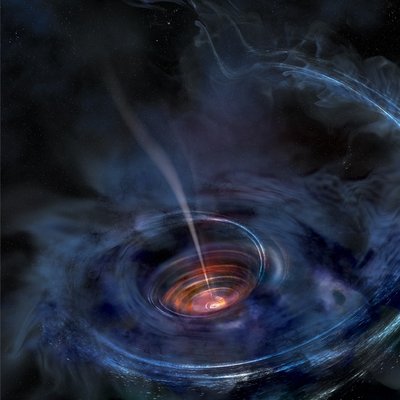Find out the latest thinking about our universe.
-
bystander
- Apathetic Retiree
- Posts: 21577
- Joined: Mon Aug 28, 2006 2:06 pm
- Location: Oklahoma
Post
by bystander » Wed Jun 22, 2016 8:14 pm
Dormant Black Hole Eats Star, Becomes X-Ray Flashlight
University of Maryland, College Park | 2016 June 22
UMD astronomers catch X-ray echoes of a tidal disruption event for the first time
[c][attachment=0]Tidal_disruption_art_AS_crop.jpg[/attachment][/c][hr][/hr]
Roughly 90 percent of the biggest black holes in the known universe are dormant, meaning that they are not actively devouring matter and, consequently, not giving off any light or other radiation. But sometimes a star wanders too close to a dormant black hole and the ensuing feeding frenzy, known as a tidal disruption event, sets off spectacular fireworks.
Astronomers from the University of Maryland and the University of Michigan are the first to document X-rays bouncing around deep within the walls of a once-dormant black hole’s newly formed accretion disk—the giant, puffy cloud of shredded star stuff circling the black hole, waiting for its turn to be swallowed up—following a tidal disruption event. Using these data, the researchers discerned the shape and activity of the accretion disk near a supermassive black hole named
Swift J1644+57.
This marks the first time such detailed observations have been made for a dormant supermassive black hole. In addition, the team’s methodology could open the door to reliable measurements of black hole spin in the near future. ...
The accretion disk has an effect somewhat like the reflective shield behind a flashlight bulb, reflecting, amplifying and focusing the radiation. The fact that X-rays can originate deep within the accretion disk of a tidal disruption event is surprising, according to Kara. Conventional wisdom among astronomers has long held that, during a tidal disruption event, high-energy X-rays are created further from the black hole in the relativistic jets—huge beams of particles ejected by the black hole and accelerated to nearly the speed of light. But seeing X-ray emissions bouncing off the walls of the inner accretion disk has cast a new light on this assumption. ...
X-ray Echoes of a Shredded Star Provide Close-up of 'Killer' Black Hole
NASA Goddard Space Flight Center | 2016 June 22
Relativistic Reverberation in the Accretion Flow of a Tidal Disruption Event - Erin Kara
et al
http://asterisk.apod.com/viewtopic.php?t=25067
-
Attachments
-

- In this artist's rendering, a thick accretion disk has formed around a
supermassive black hole following the tidal disruption of a star that
wandered too close. Stellar debris has fallen toward the black hole
and collected into a thick, chaotic disk of hot gas. Flashes of X-ray light
near the center of the disk result in light echoes that allow astronomers
to map the structure of the funnel-like flow, revealing—for the first time
—strong gravity effects around a normally quiescent black hole.
(Credit: NASA/Swift/Aurore Simonnet, Sonoma State U)
Know the quiet place within your heart and touch the rainbow of possibility; be
alive to the gentle breeze of communication, and please stop being such a jerk. — Garrison Keillor
-
bystander
- Apathetic Retiree
- Posts: 21577
- Joined: Mon Aug 28, 2006 2:06 pm
- Location: Oklahoma
Post
by bystander » Wed Jul 06, 2016 5:31 pm
Earth-size Telescope Tracks Aftermath of Star Being Swallowed by Supermassive Black Hole
Onsala Space Observatory | Chalmers University of Technology | 2016 July 06
[img3="This artist’s impression shows the remains of a star that came too close to a supermassive black hole. Extremely sharp observations of the event Swift J1644+57 with the radio telescope network EVN (European VLBI Network) have revealed a remarkably compact jet, shown here in yellow. Credit: ESA/S. Komossa/Beabudai Design"]http://www.chalmers.se/SiteCollectionIm ... 50x340.jpg[/img3][hr][/hr] Radio astronomers have used a radio telescope network the size of the Earth to zoom in on a unique phenomenon in a distant galaxy: a jet activated by a star being consumed by a supermassive black hole. The record-sharp observations reveal a compact and surprisingly slowly-moving source of radio waves.
An international team of radio astronomers led by Jun Yang (Onsala Space Observatory, Chalmers University of Technology, Sweden) studied the new-born jet in a source known as
Swift J1644+57 with the European VLBI Network (
EVN), an Earth-size radio telescope array. ...
When a star moves close to a supermassive black hole it can be disrupted violently. About half of the gas in the star is drawn towards the black hole and forms a disc around it. During this process, large amounts of gravitational energy are converted into electromagnetic radiation, creating a bright source which is visible at many different wavelengths.
One dramatic consequence is that some of the star’s material, stripped from the star and collected around the black hole, can be ejected in extremely narrow beams of particles at speeds approaching the speed of light. These so-called relativistic jets produce strong emission at radio wavelengths.
The first known tidal disruption event that formed a relativistic jet was
discovered in 2011 by the NASA satellite Swift. Initially identified by a bright flare in X-rays, the event was given the name Swift J1644+57. The source was traced to a distant galaxy, so far away that its light took around 3.9 billion years to reach Earth.
Jun Yang and his colleagues used the technique very long baseline interferometry (
VLBI) make extremely high-precision measurements of the jet from Swift J1644+57. ...
No apparent superluminal motion in the first-known jetted tidal disruption event Swift J1644+5734 - J. Yang
et al
Know the quiet place within your heart and touch the rainbow of possibility; be
alive to the gentle breeze of communication, and please stop being such a jerk. — Garrison Keillor